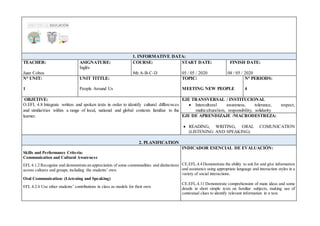Plan de clase juan cobos
- 1. 1. INFORMATIVE DATA: TEACHER: Juan Cobos ASIGNATURE: InglÃĐs COURSE: 8th A-B-C-D START DATE: 05 / 05 / 2020 FINISH DATE: 08 / 05 / 2020 N° UNIT: 1 UNIT TITTLE: People Around Us TOPIC: MEETING NEW PEOPLE N° PERIODS: 4 OBJETIVE: O.EFL 4.8 Integrate written and spoken texts in order to identify cultural differences and similarities within a range of local, national and global contexts familiar to the learner. EJE TRANSVERSAL / INSTITUCIONAL ï· Intercultural awareness, tolerance, respect, multiculturalism, responsibility, solidarity EJE DE APRENDIZAJE /MACRODESTREZA: ï· READING, WRITING, ORAL COMUNICATION (LISTENING AND SPEAKING) 2. PLANIFICATION Skills and Performance Criteria: Communication and Cultural Awareness EFL 4.1.2 Recognize and demonstrate an appreciation of some commonalities and distinctions across cultures and groups, including the studentsâ own. Oral Communication: (Listening and Speaking) EFL 4.2.6 Use other studentsâ contributions in class as models for their own INDICADOR ESENCIAL DE EVALUACIÃN: CE.EFL.4.4 Demonstrate the ability to ask for and give information and assistance using appropriate language and interaction styles in a variety of social interactions. CE.EFL.4.11 Demonstrate comprehension of main ideas and some details in short simple texts on familiar subjects, making use of contextual clues to identify relevant information in a text.
- 2. Reading EFL 4.3.2 Make use of clues such as titles, illustrations, organization, text outline and layout, etc. to identify and understand relevant information in written level-appropriate text types. Writing EFL 4.4.2 Make and use a simple print or digital learning resource to compare and contrast information in order to demonstrate understanding and command of a topic.. CE.EFL.4.16 Make use of simple learning resources, including those created by oneâs self, in order to compare and contrast information, and choose appropriate resources according to the value, purpose and audience of each. METHODOLOGICAL STRATEGIES: RESOURCES PERFORMANCE INDICATORS TECHNIQUES/INSTRUMENTS Interactives Dinamics EXPERIENCE Sharing learnersâ stories in pairs or small groups and choosing to represent some through a role play. REFLEXION Participating in short dialogues and role plays to practice target language. CONCEPTUALIZATION Giving learners language prompts to use during pair/group work. Asking classmates to repeat an answer or statement if needed to clarify something. Asking for help in class when necessary. APPLICATION Making posters in small groups of new phrases and expressions in order to display in the classroom. âĒ Studentâs Book English A1.1 (including interactive version) âĒ Audio CD âĒ Teacherâs Guide âĒ Photocopiable worksheets (TG) âĒ Quiz Time (SB) - I.EFL.4.1.1 Learners can compare and contrast oral traditions, myths, folktales and literature from Ecuador and other cultures in order to demonstrate an understanding of the relationship between cultural practices and perspectives. I.EFL.4.11.1 Learners can understand main ideas and some details in short simple online SELF APPRAISAL Technique: Test Instrument: Test (TICs) COEVALUATION Technique: Direct observation Instrument: Check list: oral presentation. HETEROEVALUACIÃN Technique: Indirect observation Instrument:
- 3. or print texts on familiar subjects, using contextual clues to help identify the most relevant information. (I.2, I.4) Graphic organizer (Round table) 3. ADAPTED CURRICULUM ESPECIFICACIÃN DE LA NECESIDAD EDUCATIVA SPECIFICATION OF THE ADAPTATION TO BE APPLIED Teachers who work with students with special needs learn how to identify disabilities in order to design personalized plans based on assessment results and empirical data. Thus, they should modify the objectives and indicators in accordance with those results, and adapt the corresponding activities. OBSERVATIONS: ELABORADO REVISADO APROBADO TEACHER: Ing: Juan Cobos COORDINADORA DE SUBNIVEL MEDIO: Ing: Juan Cobos VICERRECTORA: Lic: Maribel Ortiz Sign: Sign: Sign: Date: 04 / 05 / 2020 Fecha: 05/ 05 / 2020 Fecha: 05 / 05 / 2020
- 4. Lista de cotejo para la coevaluaciÃģn de la exposiciÃģn oral Estudiantesevaluados Grupo # âĶâĶâĶ.. Integrantes: âĶâĶâĶâĶâĶâĶâĶâĶâĶâĶâĶâĶ âĶâĶâĶâĶâĶâĶâĶâĶâĶâĶâĶ.... âĶâĶâĶâĶâĶâĶâĶâĶâĶâĶâĶâĶ Variables Criterios SI No 1. Demuestra preparaciÃģn para la exposiciÃģn. 2. Utiliza recursos de apoyo para la exposiciÃģn. 3. Muestra dominio en el desarrollo del tema. 4. Expone con claridad. 5. Maneja la exposiciÃģn suscitando la participaciÃģn. 6. Resuelve dudas de sus compaÃąeros atendiendo a sus preguntas. 7. El tono de voz es adecuado para que todo el auditorio escuche. 8. Mantiene contacto visual con el auditorio mientras expone. 9. Utiliza el lenguaje gestual como apoyo en su comunicaciÃģn. 10. Existe una buena postura corporal. Estudiantes evaluadores: âĶâĶâĶâĶâĶâĶâĶâĶâĶâĶâĶâĶ âĶâĶâĶâĶâĶâĶâĶâĶâĶâĶâĶ.... âĶâĶâĶâĶâĶâĶâĶâĶâĶâĶâĶâĶ
- 5. HETEROEVALUACIÃN ESTUDIANTEâĶâĶâĶâĶâĶâĶâĶâĶâĶâĶâĶâĶâĶâĶâĶâĶâĶâĶâĶâĶâĶâĶâĶâĶâĶâĶâĶâĶâĶâĶâĶâĶâĶâĶâĶâĶâĶâĶâĶâĶâĶâĶâĶâĶâĶâĶâĶâĶâĶâĶâĶâĶâĶâĶâĶ FECHA âĶâĶâĶâĶâĶâĶâĶâĶâĶâĶâĶâĶâĶâĶâĶâĶâĶ...GRADOâĶâĶâĶâĶâĶâĶâĶâĶâĶâĶâĶâĶâĶâĶ..PARALELOâĶâĶâĶâĶâĶâĶâĶâĶâĶâĶâĶâĶâĶâĶ.. 1. En el siguiente diagrama establecer una mesa redonda





